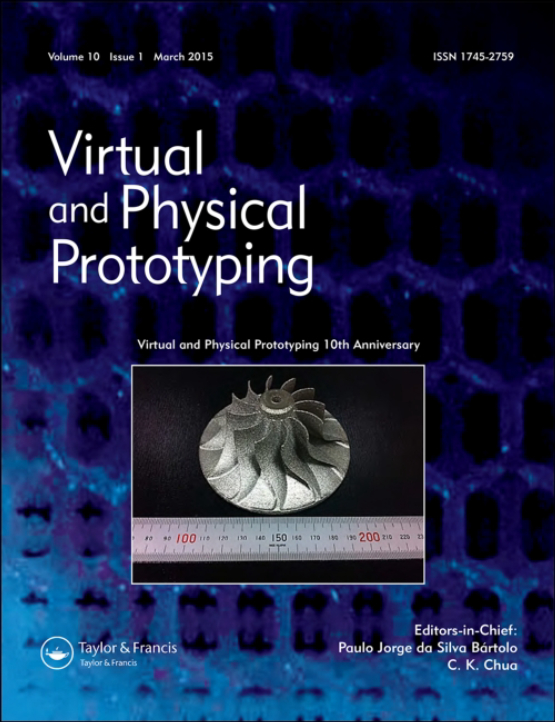Meet the Author:
Swee Leong Sing
Swee Leong Sing is an Assistant Professor at the Department of Mechanical Engineering, National University of Singapore (NUS), Singapore, and author of Virtual and Physical Prototyping. His research interests are enabling material development while creating strategic and sustainable values for Industry 4.0 and beyond through the use and integration of advanced manufacturing. Swee Leong was named a Highly Cited Researcher by Clarivate in 2024, 2023 and 2022. In 2022, he was also awarded the Young Professional Award by ASTM International for his work in additive manufacturing and contribution in standard development for the field. Swee Leong is also the co-inventor for three patents in additive manufacturing.
In this Q&A, we dive in deeper about his article “Achieving sustainability by additive manufacturing: a state-of-the-art review and perspectives”, as he explores the crucial intersection of additive manufacturing (AM) and challenges in sustainability while highlighting promising areas for future research and development.

Your article explores the potential of additive manufacturing (AM) as a path toward sustainability. What motivated your team to focus on this intersection, and what sustainability challenges are you most excited about AM helping to solve?
Additive manufacturing (AM) is inherently a key enabler in achieving sustainability in manufacturing due to its potential to reduce material waste and enable flexible designs. In reducing waste, AM produces minimal scrap by building parts directly, unlike subtractive manufacturing. By enabling flexible designs, AM allows parts to be customized, meaning each product can be tailored to the end user.
In our team, we see AM as a sustainable approach not only through new product development but also by rethinking the entire manufacturing chain. This includes using recycled materials in AM and reducing energy consumption throughout the process.
Sustainability is a widely used term in research and industry today. How do you define meaningful sustainability within the context of AM?
In AM, I believe sustainability can be viewed from two aspects. First, sustainability for AM – this focuses on how to make AM itself more sustainable. Second, sustainability by AM – how AM contributes to broader sustainability goals. AM has the potential to complement traditional manufacturing processes and reduce material and energy usage, if applied correctly. This involves looking at the materials used and the energy consumed by different AM processes.
Moreover, AM opens the door to new solutions for sustainability. For example, we have worked on redesigning urban farming systems that have components that can only be fabricated by AM.
Can you share any real-world examples where AM has already made a clear sustainability impact, whether in reducing waste, improving efficiency, or smarter design?
In our article, we have shared some of the research case studies for such applications. To add on, there are several interesting examples that are available.
For sustainability in AM, there is growing work on the use of greener materials for construction:
For sustainability by AM, researchers are exploring more efficient designs:
Another exciting area is coral restoration and preservation using 3D printing. This example from Mongabay highlights how AM is being applied in marine conservation. Within our team, we have been working on sustainable manufacturing using recycled materials (polymers and metals).


Being published Open Access, your article is freely accessible to a wide audience. In your view, how important is accessibility in helping research like yours drive industry or policy-level change?
It is critical for the research findings to be made available to the public so that the knowledge can help shape the perspectives on emerging technologies. Open access ensures that both industry professionals and policymakers can engage with the research directly, accelerating innovation and guiding more informed decisions.
As both a researcher and Deputy Associate Editor for VPP, what trends or emerging directions in AM and sustainability are you excited to see more authors explore?
When we started research in AM more than a decade ago, most research focused on adapting existing materials and product designs. That mindset is changing – and needs to. To really tap into the full potential of AM, we must explore materials specifically designed for AM, as well as design at the product level. For example, can we develop better alloys and parts with improved functional properties that are also cheaper, faster, and better to produce?
Another interesting area to look into would be the intersection of artificial intelligence into AM. AM, being a digital manufacturing thread, generates vast amounts of data. How we use this data to improve and enhance the technology is a key area for future research.
What advice would you offer to early-career researchers interested in AM and sustainability? Are there specific areas where more research or innovation is especially needed?
There are so many exciting research opportunities in AM and sustainability. For example, in the area of 3D food printing – how can we create food products that are both more sustainable and appealing to consumers? Or in the area of sustainable cities – how can AM be used to produce better systems for cooling, flood resilience and more?
The research journey is just beginning. What we’ve seen so far is only the tip of the iceberg!
About the Journal
Virtual and Physical Prototyping (VPP) provides an international forum for professionals and academics to exchange novel ideas and disseminate knowledge covering the full range of activities related to the multi-disciplinary area of virtual and rapid prototyping.
The scope of VPP includes:
Design for additive manufacturing: topological optimisation, lightweight, biomimetic design, functionally graded structures, etc.
4D printing: smart materials, shape memory polymers/alloys, deployable structures, etc.
Multi-material printing: 3D printing of multiple metals, polymers, ceramics, composites, etc.
Hybrid manufacturing: combination of additive and subtractive technologies
Functional 3D printing: functional design, functional prototyping, etc.


